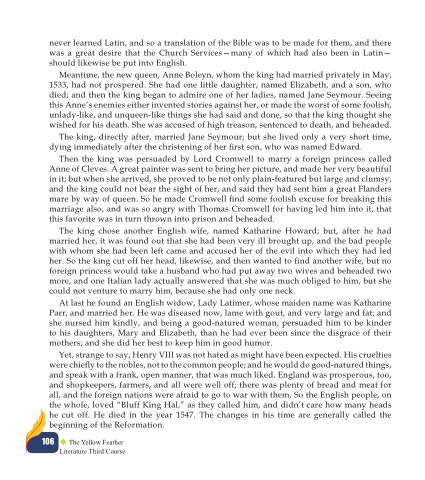Page 107 - Yellow Feather Book 2
P. 107
never learned Latin, and so a translation of the Bible was to be made for them, and there was a great desire that the Church Services—many of which had also been in Latin— should likewise be put into English.
Meantime, the new queen, Anne Boleyn, whom the king had married privately in May, 1533, had not prospered. She had one little daughter, named Elizabeth, and a son, who died; and then the king began to admire one of her ladies, named Jane Seymour. Seeing this Anne’s enemies either invented stories against her, or made the worst of some foolish, unlady-like, and unqueen-like things she had said and done, so that the king thought she wished for his death. She was accused of high treason, sentenced to death, and beheaded.
The king, directly after, married Jane Seymour; but she lived only a very short time, dying immediately after the christening of her first son, who was named Edward.
Then the king was persuaded by Lord Cromwell to marry a foreign princess called Anne of Cleves. A great painter was sent to bring her picture, and made her very beautiful in it; but when she arrived, she proved to be not only plain-featured but large and clumsy, and the king could not bear the sight of her, and said they had sent him a great Flanders mare by way of queen. So he made Cromwell find some foolish excuse for breaking this marriage also, and was so angry with Thomas Cromwell for having led him into it, that this favorite was in turn thrown into prison and beheaded.
The king chose another English wife, named Katharine Howard; but, after he had married her, it was found out that she had been very ill brought up, and the bad people with whom she had been left came and accused her of the evil into which they had led her. So the king cut off her head, likewise, and then wanted to find another wife; but no foreign princess would take a husband who had put away two wives and beheaded two more, and one Italian lady actually answered that she was much obliged to him, but she could not venture to marry him, because she had only one neck.
At last he found an English widow, Lady Latimer, whose maiden name was Katharine Parr, and married her. He was diseased now, lame with gout, and very large and fat; and she nursed him kindly, and being a good-natured woman, persuaded him to be kinder to his daughters, Mary and Elizabeth, than he had ever been since the disgrace of their mothers; and she did her best to keep him in good humor.
Yet, strange to say, Henry VIII was not hated as might have been expected. His cruelties were chiefly to the nobles, not to the common people; and he would do good-natured things, and speak with a frank, open manner, that was much liked. England was prosperous, too, and shopkeepers, farmers, and all were well off; there was plenty of bread and meat for all, and the foreign nations were afraid to go to war with them. So the English people, on the whole, loved “Bluff King Hal,” as they called him, and didn’t care how many heads he cut off. He died in the year 1547. The changes in his time are generally called the beginning of the Reformation.
106 The Yellow Feather Literature Third Course


